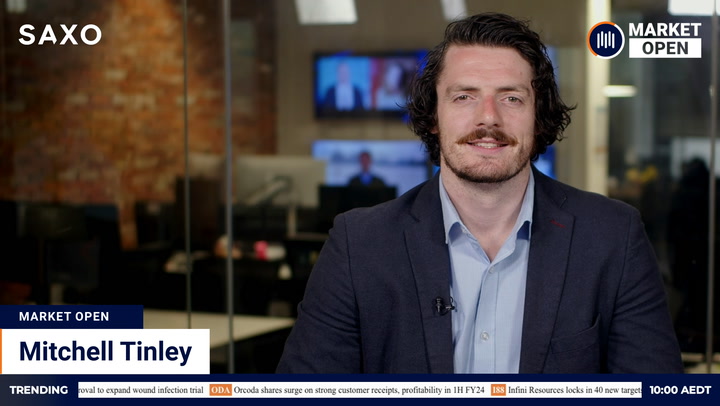A holiday-interrupted week looked set to open near an eight-month low following Wall Street’s worst week since the early days of the pandemic.
ASX futures declined 49 points or almost 0.7 per cent after US stocks logged heavy falls. An opening loss on that scale would push the S&P/ASX 200 to a level last seen in late May/early June.
Oil, gold and copper retreated. Iron ore rose for a third week.
Wall Street
The S&P 500 and Nasdaq Composite logged their worst weekly falls since March 2020 as a week-long sell-off continued on Friday. Rates jitters and a run of corporate earnings disappointments dominated a brutal week for investors.
The S&P 500 fell 85 points or 1.89 per cent on Friday. The Dow Jones Industrial Average shed 450 points or 1.3 per cent. The Nasdaq Composite gave up 385 points or 2.72 per cent.
Friday’s loss extended the Nasdaq’s weekly decline to 7.6 per cent. The tech index has fallen 14 per cent since peaking in November. Notably, last week’s carnage happened across a week shortened by the Martin Luther King Jr public holiday on Monday.
The Nasdaq has fallen for four straight weeks, its worst run since 2012 according to MarketWatch.
The S&P 500 shed 5.7 per cent for the week, finishing 8.3 per cent off the all-time high set earlier this month. The broadest of the major US indices has yet to record a weekly advance this year.
The Dow has also fallen for three straight weeks. The blue-chip average lost 4.6 per cent last week. Friday’s loss was the benchmark’s sixth in a row, its longest losing streak since February 2020.
A rocky start to the latest quarterly earnings season accounted for some of the market jitters. Results from the major banks last week largely fell short of expectations. Earnings are under pressure from higher labour and input costs amid supply-chain shortages and rising inflation.
Netflix dived 21.79 per cent on Friday after subscriber numbers grew significantly less than analysts anticipated.
“Thus far in January, upward earnings revisions tumbled to 58.6% from 71.8% in December and 70.7% in November, versus a peak of 82.3% in August,” analysts at Citigroup noted.
“Peaking of revision momentum could be a catalyst for market weakness,” they added.
The main trigger for recent weakness is the earnings threat from higher borrowing costs. The Federal Reserve meets this week and is expected to map out several rate increases this year. Central banks around the world are under pressure to tighten monetary policy quickly to rein in inflation.
Australian outlook
The great sell-off of January 2022 shows no sign yet of abating. If anything, downward momentum gained strength last week as the selling fed on itself.
As noted market commentator Jim Paulsen of The Leuthold Group said on Friday, “When markets get like they’ve gotten this week, the emotion is what takes over. Until it finds support, no one’s going care about anything fundamental.”
This week’s Federal Reserve meeting in the US looms as a potential circuit-breaker. The Federal Open Market Committee meets tomorrow night and will update the market on Thursday morning, Australian time, shortly before the domestic market resumes trade after the Australia Day holiday.
Equity markets generally look oversold in the short-term and therefore ripe for a bounce. Whether a rebound eventuates or holds will depend to some extent on how the Fed plays its cards.
The S&P/ASX 200 tumbled 2.9 per cent last week, its worst weekly performance since October 2020. Ugly though that number looks, it’s a scratch compared to the haemorrhaging on the Nasdaq. The Australian benchmark has declined barely 6 per cent from its peak, versus 14 per cent for the Nasdaq and 8.3 per cent for the S&P 500.
The domestic quarterly reporting season peaks this week. Among the big guns releasing results are: Fortescue Metals, Beach Energy, St Barbara, Iluka (Tuesday); and Newcrest, Evolution Mining, OZ Minerals (Thursday).
Today’s highlights on the domestic economic calendar are Markit’s flash January manufacturing and services sector surveys at 9 am AEDT.
The week’s most significant report lands tomorrow: the quarterly consumer price index has the potential to firm up the case for rate increases this year or ease pressure on the Reserve Bank. Business confidence figures are also due tomorrow.
IPOs: the flood of new listings is waning as the market’s appetite for risk diminishes. Virdis Mining and Minerals lists today at 12 pm AEDT. Virdis is a Perth-based gold explorer aiming to drill in Canada’s far north.
The rest of a light week currently looks like this: Felix Gold (Tuesday); Balararox, Cosmo Metals (Thursday); and Firebrick Pharma (Friday). Note that proposed listings are frequently liable to delay/cancellation.
The dollar this morning clawed back some of last week’s losses. The Aussie rose 0.26 per cent to 71.76 US cents.
Commodities
Iron ore remained a rare pocket of strength as carnage on equity markets undermined demand for other raw materials. The spot price for ore landed in China firmed US$3.75 or 2.8 per cent to US$137.40 a tonne.
The spot price improved US$10.65 or 8.4 per cent last week amid optimism demand will pick up under Chinese stimulus efforts. The People’s Bank of China cut various lending rates twice last week to help reignite a slowing economy.
Bulk metal giants BHP and Rio Tinto remained under pressure in overseas trade as sinking tides in Europe and the US lowered all ships. BHP‘s US-listed stock sank 4.5 per cent after Its UK-listed stock lost 3.16 per cent. Rio Tinto gave up 2.36 per cent in the US and 2.2 per cent in the UK.
Oil eased further from seven-year highs, falling for a second session. Brent crude settled 49 US cents or 0.6 per cent lower at US$87.89 a barrel. Despite the setback, prices improved 2.1 per cent last week for a fifth straight weekly gain.
“Traders are becoming increasingly sensitive to rate-hike expectations and fears that the Federal Reserve could choke off the economic recovery,” Tyler Richey, co-editor at Sevens Report Research, said.
Gold retreated from two-month highs, trimming a second week of gains. Metal for February delivery settled US$10.80 or 0.6 per cent lower on Friday at US$1,831.80 an ounce. The NYSE Arca Gold Bugs Index declined 2.39 per cent. For the week, gold gained 0.8 per cent.
“Although off its best levels, gold is still up for the second week, suggesting investors have been seeking protection against surging inflation and as excessive risk taking in equities and crypto came to an end,” Fawad Razaqzada, market analyst at ThinkMarkets, said.
The risk-off mood dented copper and aluminium, but other industrial metals prospered on the London Metal Exchange. Benchmark copper eased 0.3 per cent to US$9,984 a tonne. Aluminium dropped 2.6 per cent. Nickel rose 1 per cent, lead 1.1 per cent and tin 0.7 per cent. Zinc was flat.








